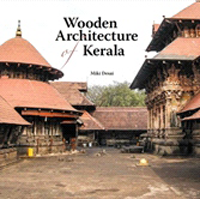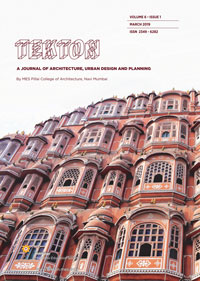Tekton
Volume 6, Issue 1, March 2019
pp. 70 – 72
Tekton
Volume 6, Issue 1, March 2019
pp. 70 – 72
Isaac Mathew
After the very popular Architecture and Independence: Search for Identity – India, 1880 to 1980 and the rigorous The Bungalow in Twentieth Century India: The Cultural Expression of Changing Ways of Life and Aspirations in the Domestic Architecture of Colonial and Post-Colonial Society, Miki Desai’s latest book, Wooden Architecture of Kerala is a refreshingly appropriate contribution to a scant landscape of architectural design writing in the country. All these books are surveys, attempts to encompass an entirety of an identified knowledge landscape. Writing practice of Mr. Desai is also a collaborative one where Madhavi Desai and Jon Lang have worked with him on earlier mentioned projects. As a solo attempt, this book compiles a set of personal observations and reflections about architecture from a region. Mostly a structured archive, the exercise collects series of ideas generated from commissioned research projects, institutional studies, documentation exercises, guided thesis projects and possibly self-funded site visits. Contemporary design education as he pointed out doesn’t accommodate regional architectural design knowledge resulting in projects that are contextually inconvenient and unsustainable. It is to address this need, the author assembles his practice revolving around the study of Indian architecture where this book records pursuits of an endeavor.

Wooden Architecture of Kerala
Author: Miki Desai
Publisher: Mapin Publishing Pvt. Ltd.
Pages: 280
Price: Rs. 1,973/- (Hard Cover)
The content compiled in this book takes the form of discussions about regional architecture and not necessarily regional wooden architecture. Though, the introducing frame (1. Wooden Architecture in the South Asian and Indian Context) is a brief overview of South Asian vernacular architecture involving geographies where traditional building culture uses wood as its primary building material, the content presented is too fleeting to derive anything substantial. It acts in the form of a list to locate Kerala’s wooden architecture. The construct for the next three chapters collected (2. Introduction to Kerala’s Society and Architecture, 3. Religious Architecture of Kerala, 4. Residential Architecture of Kerala) comes from descriptions of information which focuses on the Kerala society and its architecture based on religious and residential building typologies. Narrative logic is disconcerting since most of the text reads as a patchwork of ideas rather than a single coherent essay or content section. Next two chapters (5. The Spatial Expression, 6. Building Components, Technology and the Craftsman in Wood) articulate better but still feels predominately like a collage where certain details are missing. All these read as a collection of facts accessed from popular discussions and conversations about Kerala architecture but possibly now for this instance strung together. A larking urgency throughout the text is to present or see ideas from Gujarat. Direct comparison at instances clouds observations especially in the case of recognizing societal changes.
Vijayan K. Pillai, in his forward suggests this work as an exemplar of an ‘ethnographic architecture’ study. Generally vernacular architecture is mostly recorded as observed and never methodologically investigated. Argument proposed here is for academic concerns of building practices of regional communities assembled on frameworks of heritage conservation. Seeing the vernacular through these lenses, display knowledge gaps in the study of regional architecture. Under the agency of preservation just the building or spatial configurations are documented. Systematic readings of the culture to influence these building practices are missed out in processes that objectify architecture and its trappings. Multidisciplinary skillsets have solutions to overcome inadequacies of singular overriding dominant working patterns. A need of systematic ethnographic building science studies are evident when there’s a lack of institutional mandate to first study communities then the architecture they employ. Social changes and its resultant manifestations in the built fabric should get reviewed before any effort is made to document its architecture. For e.g. application of buildings materials such as wood becomes a concern when a community loses interest in using it. Industries that are dependent on specific culture of production move on owing to a lack of patronage and shifting priorities. Reintroducing it for popular acceptance needs alternate strategies than enforcing cultural heritage mandates or building guidelines.
Narratives laid out with this study is the ideal platform to introduce such priority shift. For an alternate structure of this work could be that the text starts with availability of the type of wood used in building construction in a region and a history of the processing technology available. This should be followed by methods of application and prominent practices and finally developing these further to specific typological and spatial case studies. These are directional possibilities and there may be other possibilities to study. But for now, a conversation on regional building practices begins. Any attempt to build on the discussion is urgent, therefore making this book is a definite marker to relook how regional vernacular studies are conducted.
 Isaac Mathew is an architect who is trying to establish a research-based building sciences practice. He is Architecture and M.Arch. (by research) from Sir. J. J. College of Architecture. He has 12 years of work experience where he worked on traditional architectural practices in the first two years and later he worked on urban design research. For the past two years he is into academia.
Isaac Mathew is an architect who is trying to establish a research-based building sciences practice. He is Architecture and M.Arch. (by research) from Sir. J. J. College of Architecture. He has 12 years of work experience where he worked on traditional architectural practices in the first two years and later he worked on urban design research. For the past two years he is into academia.
isaac@machimach.com
TEKTON JOURNAL ISSUES

EDITORIAL
PAPERS & ESSAYS
Bow Barracks – The Identity of Anglo-Indians in Kolkata: Fight for Survival
Kanupriya Goel and Shivashish Bose
 [pp. 8 – 23]
[pp. 8 – 23]
Social Life in a Smart Neighbourhood, The Case of K. K. Nagar, Chennai
Devyani Gangopadhyay and Prathyusha Ravi
 [pp. 24 – 39]
[pp. 24 – 39]
Urban Fringe Development around Bannerghatta National Park, Bangalore
Dakshayini R. Patil and Mamatha P. Raj
 [pp. 40 – 57]
[pp. 40 – 57]
Dialogue
Landscape Lens – A View of Public Parks and Landscape Practices
Reshma Sathe in conversation with Ar. Aniket Bhagwat
 [pp. 58 – 65]
[pp. 58 – 65]
BOOK REVIEW
Phenomenology in Architecture
Merleau-Ponty: Space, Place, Architecture, Patricia M. Locke (Ed), Rachel Mccann (Ed). Ohio University Press (2016)
Fatema Kabir
 [pp. 66 – 69]
[pp. 66 – 69]
Wooden Architecture of Kerala, A Review
Wooden Architecture of Kerala, by Miki Desai. Mapin (2019)
Isaac Mathew
 [pp. 70 – 72]
[pp. 70 – 72]
